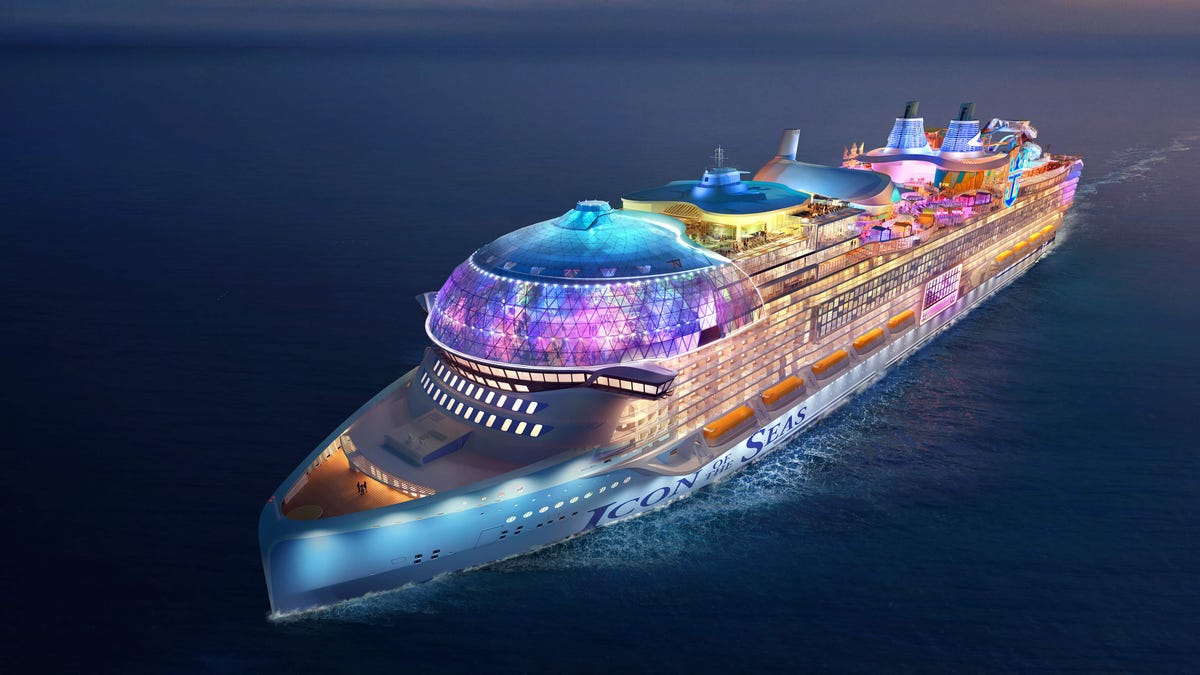The Icon Of The Seas is Royal Caribbean’s newest two-billion dollar boondoggle. Boasting twenty decks and capacity for 7,600 guests (plus 2,350 crew), this is the single largest cruise ship in the world. It is scheduled to sail for the first time on January 27, and will conduct seven-night hops around the Caribbean islands until April. Demand for cruise tourism is at an all-time high, and the Icon’s first run on the ocean sold out in October of 2022. This is all despite the cruise industry’s per-passenger carbon emissions more than double that of airlines.
Cruise Lines International Association predicts that passenger volume will hit 36 million in 2024, which is up around twenty percent from pre-pandemic records set in 2019. Cruise-related emissions plummeted to nearly zero during the COVID-19 pandemic-related pause in sailing, but by August of 2021 the industry had not only returned to pre-pandemic emissions, but exceeded those numbers. Climate Trace says that new heights have been reached, nearly six percent higher emissions from cruising as compared to before 2020.
While many cruise ship companies have publicly committed to carbon neutrality by 2050, there doesn’t seem to be much effort in the present day to reach those goals. Royal Caribbean has committed to build at least three more “Icon-class” ships for its fleet in the near future, each weighing over 200,000 tons, and powered by liquid natural gas.
The Icon Of The Seas has two giant 307-ton LNG tanks onboard to power its six Wärtsilä-built 14-cylinder 4-stroke engines making 121,400 horsepower combined. All that power will get the Icon up to its top speed of 25 miles per hour. Allegedly these engines are the most fuel efficient engines on the market, and Wärtsilä brags about “low exhaust gas emissions,” though doesn’t give consumption numbers.
Liquid natural gas is touted by the cruise industry as one of the greenest fuels on the planet. And compared to the bunker fuel these companies have been burning for decades, it might be a step in the right direction. LNG cuts sulfur and nitrogen oxide emissions significantly, and many claim the effect is a 30 percent reduction in greenhouse gas emissions.
Unfortunately for the world, cruise ships running on natural gas sometimes leak methane directly into the atmosphere, which is around 80 times more potent a greenhouse gas than carbon dioxide. A 2023 investigation concluded that ships switching to LNG was a net detriment to the climate. It doesn’t bode well, then, that Royal Caribbean has a history of dumping chemicals, and was given an “F” report card for its fleet by the non-profit organization Friends Of The Earth.
According to the Environmental Protection Agency, an average cruise ship emits more soot per day than 1 million cars. In fact, cruise ships make up just one percent of the world’s large boats, but account for more than six percent of the world’s black carbon (soot) emissions. Black carbon isn’t good anywhere, really, but it’s particularly bad in the Arctic, where it settles on snow and ice, accelerating the rate at which glaciers melt.
Bloomberg sheds some light on the emissions monstrosity that is the cruise industry:
Unlike flying, whose climate impact spurred flygskam, or flight-shaming, cruise ships don’t always get the same environmental scrutiny. That’s in part because shipping is often seen as more energy-efficient than air travel, which is true for cargo ships thanks to their relatively small living areas and efficient use of space. Cruise ships, by contrast, are energy hogs: Paying vacationers expect more square footage, and modern cruises offer a slew of amenities.
“You’ve got things like heating the pool and keeping the lights on,” Comer says. “[You] have heating and air conditioning; you’ve got the casino. There’s just a lot of equipment to keep running to keep everybody entertained and comfortable.”
People who love cruises enjoy the ability to leave their cars behind and walk from their room to any number of high-quality restaurants, water parks, shopping experiences, and entertainment venues. They’re paying thousands of dollars and emitting untold tons of carbon in order to enjoy the walkable city they spend the rest of the year NIMBY-ing against.
You don’t need to go on a cruise. And you especially don’t need to go on this cruise.

